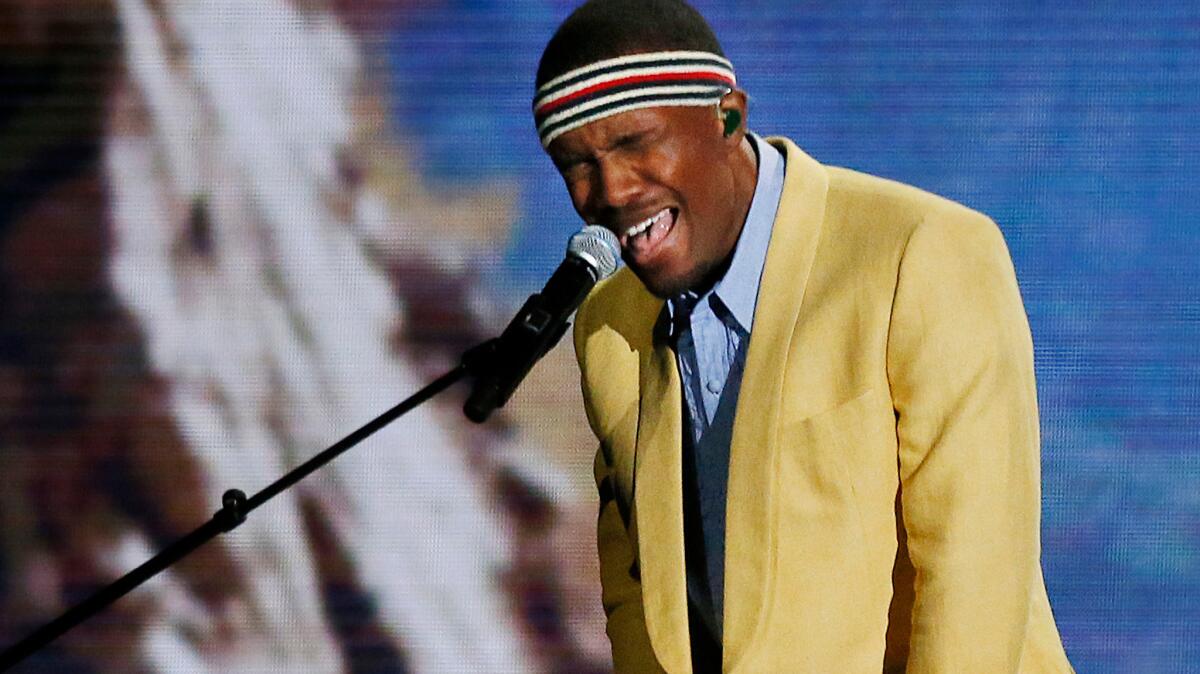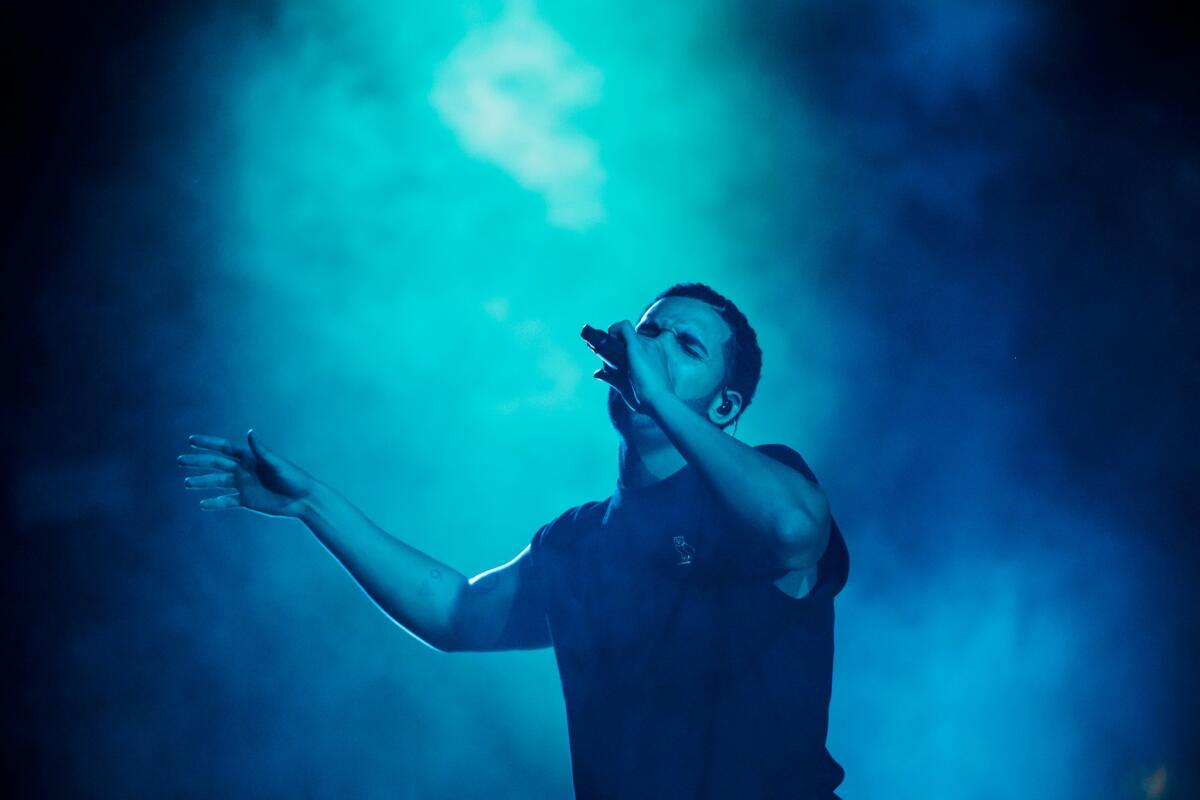What makes for a No. 1 album in the on-demand age of streaming?
- Share via
The Grammy-winning R&B singer Frank Ocean recently released two albums and a full-color, high-gloss magazine over the course of two days. In doing so, he injected enthusiasm, confusion and yet more chaos into an ever-evolving music business.
The unveiling, the latest in a line of innovative, high-profile maneuvers, disrupted the U.S. album charts. Where did Ocean end up on the chart? At No. 1, but how he got there is not as simple as it used to be.
On Monday’s Billboard Top 200 album count, the Apple Music-released “Blonde” debuted at No. 1, with a first-week tally of over 275,000 “equivalent album units” sold — note the wording in quotes.
So, what, exactly, is an equivalent album? It’s a complicated mash-up of streaming and sales data, where 10 digital-track downloads sold and 1,500 songs streamed are equal to one album.

In Ocean’s case, he sold 232,000 digital-album downloads of “Blonde,” according to Nielsen Music. The album then accrued 65 million streams of its individual tracks. That number in turn is divided by 1,500 to arrive at what, for charting purposes, essentially amounts to an additional 43,000 albums sold (individual tracks from the release were not made for sale).
Got all that? You’re forgiven if not.
“It’s kind of the Wild West and it always has been. People are just trying to figure it all out,” says Tim Smith, who as founder of Blood Company manages major electronic artists including Skrillex, Zedd and Boys Noize.
In recent years the task of tabulating a record’s success and popularity has grown more complicated. What used to be an album sale is now an “equivalent album sale.” Each component — that is a song — of a release — otherwise known as a project — is measured and weighted using industry-approved equations.
Simple math? Far from it.
Whereas one album plus another album once equaled two albums, in an on-demand era of streaming and instant downloads, one better bring a calculator to unravel the new chart language. What was once as simple as adding up the sales of a few different formats has now become an SAT-worthy calculation.
Trying to distill it all are companies Nielsen Music and BuzzAngle, which track physical and digital sales and stream numbers in order to gauge success in an evolving, fluid business.
“When you say it’s the top album, you have to clarify that,” says Jim Lidestri, CEO of Border City Music, which owns BuzzAngle. “What does that mean?”
This whirlwind year has seen superstars Beyoncé, Kanye West and Chance the Rapper unveil new work through a variety of avenues, including exclusives with streaming services and surprise album drops.
And with them, consistency has become a thing of the past.
The year’s biggest album, Drake’s “Views,” premiered exclusively through Apple Music and iTunes — but only after the artist played it in full on his OVO Music radio show on Apple’s Beats 1 radio platform. At the end of its first week, “Views” had sold over 850,000 digital albums and generated nearly 250 million audio streams, according to BuzzAngle.

The album, which spent much of the summer at No. 1, debuted on the Billboard chart with what Nielsen said was 852,000 albums sold and 1.04 million equivalent album sales.
The Canadian rapper eventually expanded its availability to other streaming platforms, the accumulation of which kept the record in the No. 1 slot for three months.
“There are a lot of creative strategies being tried out there,” says David Bakula, who oversees chart tabulation for Nielsen as senior vice president, analytics and client development. The problem, however, is quantifying success in an era with dozens of distribution platforms.
“I don’t think there’s a great sense from everybody out there of, ‘This is what it takes to get to No. 1,’ or ‘This is even what a level is for No. 1,’” says Bakula.
For his part, Ocean’s competing release strategy was prompted by his first new music in four years. His long-gestating album, once thought to be called “Boys Don’t Cry,” turned out to be two albums — “Endless” and “Blonde.” Only the latter is eligible to be counted on the album chart. Because it’s a video album, “Endless” is excluded.
See the most-read stories in Entertainment this hour >> »
Also notably absent from the overall calculations from Nielsen and BuzzAngle are the billions of YouTube plays, which are hard to quantify due to the volume of fan-made clips that feature incidental use of hot songs. What’s more, radio streaming service Pandora’s charts aren’t considered either, since the album tallies are designed to calculate intentional, on-demand listens.
Whew.
The result is a formula far more complicated than a decade ago, when labels measured success based on the volume of downloads, discs and records sold.
Twenty-five years ago the music industry experienced a revolution when it started using SoundScan as a data-analysis partner. For the first time, a system existed to calculate album sales in real time.
Using bar codes, it registered each purchase, replacing the old method of relying on (easily bribed) retail managers to phone in each week’s top sellers. An album sold — whether on vinyl, cassette or compact disc — was an album sold. As digital downloads entered the equation, the charts adapted accordingly.
Streaming, however, introduced a host of new variables, and two years ago Nielsen, which now owns SoundScan, introduced sweeping changes in an attempt to account for the arrival of services like Spotify, Google Music and Apple Music.
In order to accurately represent the market, says Nielsen’s Bakula, analysts needed to consider the ways in which technology had changed the variables.
The solution, in layman’s terms?
“We’re going to mash it all together in this formula and we’re going to come up with this number for total volume,” says Bakula. “That was the most challenging part.”
Hence what used to be considered an “album” is now called an “equivalent album unit,” and is measured through a weighted equation based on varying factors. Was it purchased for download, compact disc or LP? How many times were songs from the album streamed through on-demand services such as Apple Music, Spotify and Tidal?
“The consumer is like, ‘Wow, that’s complicated when you try and explain it,” says BuzzAngle’s Lidestri.
Still, it’s worth a shot.
Currently, the industry standard for measuring streaming activity is calculated using the aforementioned ratio of 1,500 streaming spins to one album. As well, 10 purchased digital downloads equals one album sale.
Nielsen and BuzzAngle employ different calculations to determine their daily numbers, which results in slightly varying totals. Both, however, use as the heart of their digital tracking the 1,500-to-1 and 10-to-1 ratios.
Thus, it doesn’t matter if, say, Drake’s “Hotline Bling,” “One Dance” and “Too Good” accrue the majority of spins or purchases from “Views” at the expense of the album’s less popular tracks, nor does it matter whether a listener plays an album from start to finish.
What matters is the listener’s decision to invest either time or money in music.
“A sale is still the ultimate vote by the consumer. That’s taking money out of the pocketbook,” says music industry analyst Geoff Mayfield, formerly of Billboard and Universal Music and currently a consultant for BuzzAngle. “Whether you’re clicking online or still buying a physical album.”
Mayfield adds that sales account for a bigger chunk of the equation.
“That’s still the ultimate vote of a consumer’s endorsement,” says Mayfield. “But what that doesn’t capture — and one of the things that’s being brought into play by incorporating streams and song sales — is the continuing popularity of an album.”
Drake’s 2016-leading run with “Views” is the result of a devoted fan base who streamed the record throughout the summer, says Mayfield.
“That’s made all the difference in the world. An album like Drake’s would probably only be No. 1 for a week or two if it was a sales-only chart. This way, the fact that it continues to be popular in the streaming world is reflected here.”
The album is one of only seven in history to surpass 1 billion streams, according to Billboard.
The result, according to Bakula, is that after the first rush of sales tapers off, streaming takes over: “This isn’t about album purchases anymore. This is about constant, ongoing consumption of all the components of the album.”
By most measurements, Ocean’s first-week tally is enviable. Nearly a week after it was released, 17 of the top 20 spots on Apple Music’s “Top Songs” chart were occupied by the “Blonde” tracks. The artist’s name was trending on Twitter and Instagram throughout its release weekend, as fans rejoiced at the arrival of new projects. Some raced to pop-up shops in four major cities, and car stereos across Los Angeles amplified Ocean’s voice.
How do you measure that brand of ubiquity?
You can’t, says Skrillex manager Smith, and it won’t get any easier. “There are going to be more ways to consume and more ways to be exposed to art, so nothing is ever entirely accurate, and nothing can really cover everything because it’s going to be pretty physically — slash digitally — impossible.
“It changes so quickly that everybody tries different things,” adds Smith. “That’s part of the excitement, I think, today. And certainly in the future it’s only going to get wilder and more interesting.”
There’s a lot of terrible music out there. For tips on the stuff that’s not, follow Randall Roberts on Twitter: @liledit
ALSO
Frank Ocean’s minimalism sets ‘Blonde’ apart from recent releases by Beyoncé, Rihanna and Kanye West
Contradictions abound on Drake’s bitter but sensual ‘Views’
Britney can’t come close to matching Beyoncé’s fire at MTV VMAs
More to Read
The biggest entertainment stories
Get our big stories about Hollywood, film, television, music, arts, culture and more right in your inbox as soon as they publish.
You may occasionally receive promotional content from the Los Angeles Times.







